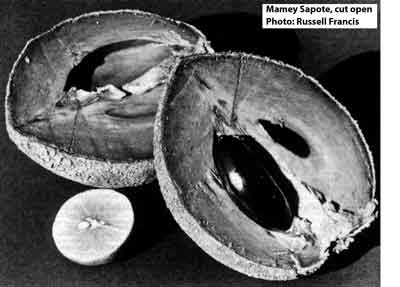
MAMEY SAPOTE in PUERTO RICO
SCIENTIFIC NAME: Pouteria sapota
FAMILY: Sapotaceae
Sapote or mamey sapote, a tree with milky latex, is rarely cultivated for its large edible fruits. Identified by: 1) mostly large reverse lance-shaped (oblanceolate) or narrowly obovate leaves, short- or long-pointed at apex and gradually tapering to long-pointed base, clustered at ends of stout twigs; 2) many cup-shaped or bell-shaped pale yellow flowers about ½ inch long, almost stalkless in clusters on twigs back of leaves; and 3) brown egg-shaped to elliptic fruits 4-6 inches long and 3-4 inches wide, with sweetish soft pink-red or purplish flesh and milky sap.
Medium-sized tree 30-40 feet high and 1½ feet in trunk diameter, elsewhere becoming much larger, to 80-100 feet tall and 2 feet or more in trunk diameter. The rounded crown has evergreen or deciduous foliage. The bark is reddish brown and shaggy with milky sap or latex. The stout gray twigs are finely rusty-red hairy at apex and bear leaves singly (alternate) but clustered near ends.
Petioles are ½ to 1½ inches long, rusty-red hairy when young. Blades are mostly 5-14 inches long and 1½ to 5 inches wide, thickened and leathery, slightly shiny or dull, the prominent lateral veins straight and parallel, nearly hairless except on veins beneath, the upper surface dark green and the lower surface light green.
Many flowers are produced along the stouter twigs back of leaves, several together and almost stalkless. There are 8-12 overlapping light brown rounded hairy sepals ⅛-¼ inch long, the large yellow ones inside; the pale yellow corolla 3/8 inch long with tube and five blunt lobes a little longer than the tube, spreading slightly to 3/8 inch long, with conical 5-celled ovary and style.

The brown finely scaly, edible fruit (a berry) is rounded at the base and blunt-pointed at apex. There are 1 or 2 large elliptic shiny brown seeds 2½-3 inches long, slightly flattened and with long, gray, rough, scar-like area on one side.
The wood is light reddish or brown, moderately hard and heavy (specific gravity about .6), strong and fairly durable. Elsewhere it has been used in rural carpentry and for cabinetwork and carriages, but generally the trees are saved for their fruits.
Sapote or mamey sapote is one of the best-known native fruit trees of tropical America. The fruits have a distinctive sweetish flavor, or are insipid to some persons, and usually are eaten raw. However, they may be prepared into a marmalade or jelly and sherbets and ice cream. Elsewhere, the ground seeds, which have a flavor like bitter almonds have served as sweetmeats for flavoring chocolate and candy, and in a beverage. The seeds also are reported to be poisonous. Oil from the seeds was used by the Aztec Indians for dressing the hair and has been employed in home medicine. Sapote is also a honey plant.
Rarely planted at low altitudes in Puerto Rico, at Bayamón for example, for fruit and shade, but not native or naturalized. Also reported from Virgin Islands.
Range - Widely planted in tropical America and southern Florida and Bermuda through West Indies from Cuba to Grenada and Trinidad and Tobago and from southern Mexico through Central America to Ecuador and Brazil. The original natural range uncertain, probably southern Mexico and northern Central America to Nicaragua. Found native in northeastern Nicaragua.
Other common names - mamey rojo, sapote (Puerto Rico); sapote, zapote, mamey, mamey colorado (Spanish); zapote colorado, zapote mamey (Mexico); sapote grande (Nicaragua); zapotillo (Costa Rica); mamey de tierra (Panama); sapote (English); mamee sapota (Bermuda); mamee apple, Mammee-sapote (Belize); sapotier jaune d'oeuf, sapotillier marmelade, grand sapotillier (Haiti); sapote à creme (Guadeloupe); sapote, grosse sapote (Martinique); sapota (Brazil).
Botanical synonyms Calocarpum mammosum (L) Pierre, C. sapota (Jacq.) Merrill, Lucuma mammosa (L) Gaertn. f., Pouteria mammosa (L) Cronq.
Editor's note: This delicious fruit, much beloved here in South Florida, especially among our Hispanic population, has become increasingly popular throughout the world since this book was published. The general public is discovering its rich and wonderful taste through sherbets and ice creams, and the number of plantings has risen accordingly.
DATE: March 1994
* * * * * * * * * * * * *
